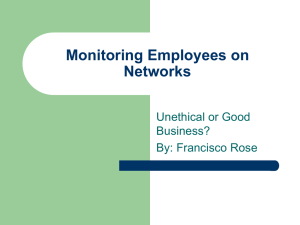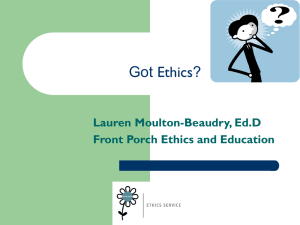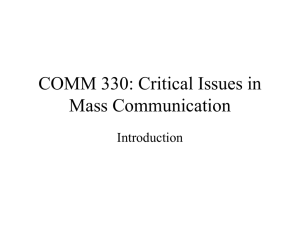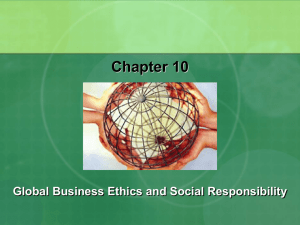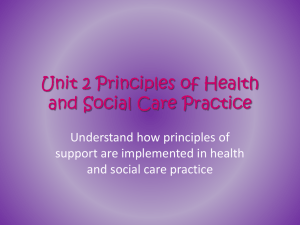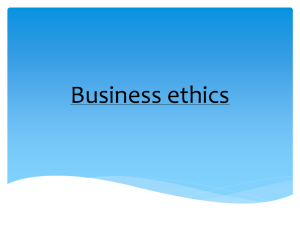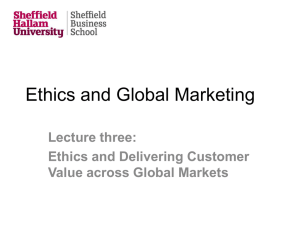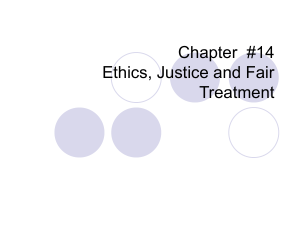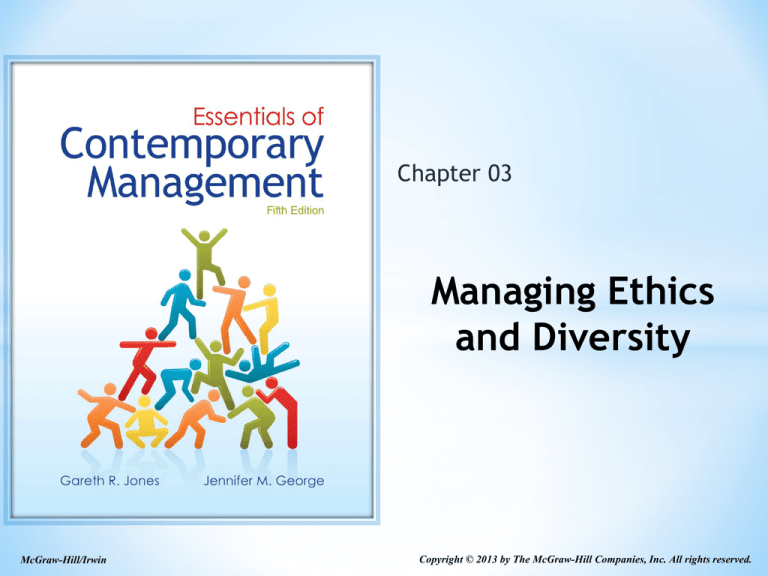
Chapter 03
Managing Ethics
and Diversity
McGraw-Hill/Irwin
Copyright © 2013 by The McGraw-Hill Companies, Inc. All rights reserved.
Learning Objectives
• Illustrate how ethics help managers determine the
right way to behave when dealing with different
stakeholder groups
• Explain why managers should behave ethically and
strive to create ethical organizational cultures
• Appreciate the increasing diversity of the
workforce and of the organization environment
3-2
Learning Objectives
• Grasp the central role that managers play in the
effective management of diversity
• Understand why the effective management of
diversity is both an ethical and a business
imperative
• Understand the two major forms of sexual
harassment and how they can be eliminated
3-3
The Nature of Ethics
• Ethical dilemma: Quandary people find themselves
in when they have to decide if they should act in a
way that might help another person or group even
though doing so might go against their own selfinterest
3-4
The Nature of Ethics
• Ethics: Inner-guiding moral principles, values, and
beliefs that people use to analyze or interpret a
situation and then decide what is the “right” or
appropriate way to behave
• Ethics indicate inappropriate behavior and how a
person should behave to avoid harming another
person.
• The essential problem in dealing with ethical
issues is that there are no absolute or
indisputable rules or principles can be developed
to decide if an action is ethical or unethical.
3-5
Ethics and the Law
• Laws and ethics are not fixed principles. Ethical
beliefs change over time, and as they do, laws also
change to reflect the changing ethical beliefs of a
society.
• . “Do unto others as you would have them do unto
you” is a commonly used ethical or moral rule that
continues to be useful.
3-6
Changes in Ethics over Time
• Many behaviors, such as murder, theft, and rape that
people find totally unacceptable should remain illegal.
However, there are other actions and behaviors whose
ethical nature is open to dispute. Examples include gun
possession or the use of tobacco.
• . It is important to note that laws themselves change as
ethical beliefs change. There is no absolute or unvarying
standard to determine how we should behave.
• In the 2000s, scandals such as Enron, WorldCom, and Tyco
broke the law and used illegal and unethical means to
defraud investors
• Not being illegal does not make behavior ethical
3-7
*
*Ethical behavior
*Accepted principles of right and wrong
*Workplace deviance
*Unethical behavior that violates organizational
norms about right and wrong
*Production deviance-hurts the quality and
quantity of work produced.
*Property deviance-unethical behavior aimed at
company property or products.
*Political deviance-using one’s influence to harm
others.
*Personal aggression-hostile
or aggressive
8
behavior.
*
1.1
Source: Republished with permission of Academy of Management, P.O .Box 3020, Briar Cliff Manor, NY, 10510-8020. “A Typology of Deviant
Workplace Behaviors,” (Figure), S. L. Robinson & R. J. Bennett. Academy of Management Journal, 1995, Vol. 38. Reproduced by
permission of the publisher via Copyright Clearance Center, Inc. 62 P a r t 1 : I n t r o d u c t i o n t o M a n a g e m e n t
9
Stakeholders and Ethics
• Stakeholders: People and groups that supply a
company with its productive resources and so have
a claim on and stake in the company
• Stakeholders can directly benefit or be harmed by
an organizations actions, the ethics of a company
and its managers are important to them
3-10
Figure 3.1 - Types of Company
Stakeholders
3-11
Stockholders
• Stockholders have a claim on a company because
when they buy its stock, they become its owners.
• Stockholders are interested in the way a company
operates because they want to maximize their
return on investment.
• They want to ensure that managers are behaving
ethically and not risking investors’ capital by
engaging in actions that could hurt the company’s
reputation
3-12
Managers
• Responsible for using a company’s financial,
capital and human resources to increase its
performance
• Have the right to expect a good return or reward
by investing their human capital to improve a
company’s performance
• Difficult decisions challenge managers to uphold
ethical values
3-13
Question
Is it ethical for managers to receive vast amounts of
money from their companies?
A. Yes
B. No
C. Sometimes
D. Never
3-14
Employees
• Employees expect to receive rewards consistent
with their performance.
• A company can act ethically towards its employees
by creating an occupational structure that rewards
them fairly and ethically.
3-15
Suppliers and Distributors
• Suppliers expect to be paid fairly and promptly for
their inputs
• Distributors expect to receive quality products at
agreed-upon prices
3-16
Customers
• Most critical stakeholder group
• Managers work very hard to create loyal customers,
attract new ones, and improve the products that
they sell to customers over time
3-17
Community, Society, and Nation
• The effects of the decisions made by companies and their
managers permeate all aspects of the communities,
societies, and nations in which they operate
• Community - Physical locations like towns or cities or to
social milieus like ethnic neighborhoods in which companies
are located
• Through the salaries, wages, and taxes it pays, a
company contributes to the economy of the town or
region in which it resides and often determines whether
it prospers or declines.
• Companies affect the prosperity of a society and a
nation, and to the extent that a company is involved in
global trade, it affects the prosperity of the global
economy.
3-18
*
Ethical Intensity of Decision
Ethical
Answers
Depend
on…
Moral Development of Manager
Ethical Principles Used
3
19
*
Magnitude of consequences
Social consensus
Probability of effect
Temporal immediacy
Proximity of effect
3.1
Concentration of effect
20
*
Preconventional
Conventional
Postconventional
1. Punishment and
Obedience
3. Good boy,
nice girl
5. Social contract
2. Instrumental
Exchange
4. Law and order
6. Universal
principle
Self-Interest
Societal
Expectations
3.2
21
Internalized
Principles
*
* Magnitude of consequences -the total harm or benefit
derived from an ethical decision.
* Social consensus -agreement on whether behavior is good
or bad.
* Probability of effect -the chance that something will
happen and then result in harm to others.
* Temporal immediacy -the time between an act and the
consequences.
* Proximity of effect -the social, psychological, cultural, or
physical distance of a decision maker from those affected
by his decision.
* Concentration of effect -how much an act affects the
average person.
22
Figure 3.2 - Four Ethical Rules
3-23
Rules for Ethical Decision Making
• The utilitarian rule defines an ethical decision as one
that produces the greatest good for the greatest
number of people. Therefore, managers should
consider how different courses of action can benefit or
harm stakeholders, and implement the one with the
most benefits.
• The moral rights rule defines an ethical decision as
one that best maintains and protects the fundamental
rights and privileges of the people affected by it.
Therefore, managers should compare and contrast
alternative courses of action based on the effect of
those alternatives on stakeholders’ rights.
3-24
Rules for Ethical Decision Making
• The justice rule defines an ethical decision as one
that distributes benefits and harms among
stakeholders in a fair, equitable or impartial way.
Therefore, managers should compare and contrast
alternative courses of action based on the degree
to which the action will promote a fair distribution
of outcome to stakeholders.
3-25
Practical Decision Model
• The practical rule defines an ethical decision as one
that a manager has no hesitation communicating to
others both inside and outside of the company because
they would find it acceptable. A manager can assume a
decision is ethical if he or she can answer ‘yes’ to the
following three questions:
• Does my decision fall within the accepted values or
standards that typically apply in business activity today?
• Am I willing to see the decision communicated to all
people and groups affected by it—for example, by having
it reported in newspapers or on television?
• Would the people with whom I have a significant personal
relationship, such as family members, friends, or even
managers in other organizations, approve of the decision?
3-26
Why Should Managers Behave
Ethically?
• The relentless pursuit of self-interest can lead to a
collective disaster if individuals start to profit from
being unethical, encouraging other people to act in the
same way.
• The pursuit of individual self-interest with no
consideration of societal interests leads to disaster for
each individual and for the whole society because
scarce resources are destroyed. This situation is called
the ‘tragedy of the commons.”
• Unethical behavior ruins business commerce, and
society has a lower standard of living because fewer
goods and services are produced.
3-27
Why Should Managers Behave Ethically?
• When stakeholders believe that they are dealing with
others who are basically moral and honest, trust exists.
Over time, trust between stakeholders allows them to
work together more efficiently and effectively, thus
raising company performance. As people see the
positive results of acting in an honest way, ethical
behavior becomes a valued social norm.
• If other individuals or groups copy the behavior of the
unethical stakeholder, the rate at which collective
resources are misused increases, and eventually there
will be only few resources available for producing
goods and services.
3-28
Why Should Managers Behave Ethically?
• Reputation is the esteem or high repute that
individuals or organizations gain when they behave
ethically. If a manager misuses resources and if
other parties regard that behavior as being at odds
with acceptable standards, the manager’s
reputation will suffer.
3-29
Figure 3.3 - Some Effects of
Ethical and Unethical Behavior
3-30
Question
What is confidence and faith in another person’s
goodwill?
A. Reputation
B. Trust
C. Empathy
D. Hope
3-32
Sources of an Organization’s Code of
Ethics
• Codes of ethics are formal standards and rules,
based upon beliefs about right or wrong, that
managers can use to help themselves make
appropriate decisions concerning the interests of
their stakeholders.
• An organization’s code of ethics is derived from
three principal sources in the organizational
environment.
• They are societal ethics, professional ethics, and
individual ethics.
3-33
Sources of an Organization’s Code of
Ethics
• Societal ethics are standards that govern how
members of a society deal with each other in
matters involving issues such as fairness, justice,
poverty, and the rights of the individual.
• Societal ethics emanate from a society’s laws,
customs, and practices, and from unwritten
attitudes, values, and norms that influence how
people interact with each other.
3-34
Sources of an Organization’s Code of
Ethics
• Professional ethics are standards that govern how
members of a profession, including managers or
workers, make decisions when the way in which
they should behave is not clear-cut.
• Individual ethics are personal values (both
terminal and instrumental) and attitudes that
govern how individuals interact with other people.
• Sources of one’s individual ethics include the
influence of family, peers, personality, and
experience.
3-35
Figure 3.4 - Sources of an
Organization’s Code of Ethics
3-36
Ethical Organizational Cultures
*Managers must ensure that important ethical norms
and values are central components of the
organization’s culture.
*Employees expect those in become role models of
ethical conduct, knowing that subordinates scrutinize
their behavior.
*Organizations can encourage an ethical culture by
creating the role of ethics officer, or ethics
ombudsman.
*The ethics ombudsman is responsible for
communicating ethical standards to all employees,
designing systems to monitor employees’ conformity
to those standards, and teaching all employees how
to respond to ethical dilemmas appropriately.
3-37
Diversity of the Workforce and the
Environment
• Diversity: Differences among people in age, gender, race,
ethnicity, religion, sexual orientation, socioeconomic background,
and capabilities/disabilities
• Managing diversity fairly and justly can improve organizational
effectiveness
• Diversity is a critical issue in organizations for the following
reasons:
• There is a strong ethical imperative in many societies that
diverse people must receive equal opportunities and be
treated fairly and justly. Unfair treatment is illegal.
• Effective management of organizational diversity can improve
organizational effectiveness.
• There is substantial evidence that diverse individuals continue
to experience unfair treatment in the workplace as a result of
biases, stereotypes, and overt discrimination.
3-39
*
Diversity
*
1.1
May exist without a
program
*
*
*
Broad focus
*
Generally accepted
Not legally based
Create a positive
work environment
Affirmative Action
40
A purposeful,
established program
Narrow focus
Legal requirement
Compensate for past
discrimination
Controversial
*
To create a positive work environment where…
no one is advantaged or disadvantaged
“we” is everyone.
everyone can do his or her best work.
differences are respected and not ignored.
everyone feels comfortable.
1.1
41
Diversity Concerns
• The ethical imperative for equal opportunity
• The continuing bias toward diverse individuals
• Glass ceiling: Metaphor alluding to the invisible
barriers that prevent minorities and women from
being promoted to top corporate positions
• The federal Glass Ceiling Commission Report
indicated that African Americans have the
hardest time climbing the corporate ladder,
Asians are often stereotyped into technical jobs,
and Hispanics are assumed to be less educated
than other minority groups.
3-42
Question
What is the metaphorical barrier that prevents
minorities and women from being promoted to top
corporate positions?
A. Gender barrier
B. Gender prejudice
C. Glass ceiling
D. Glass top
3-43
Figure 3.5 - Sources of Diversity in the
Workplace
3-44
Workforce Diversity: Age
• Aging U.S. population
•
By 2030, 20 percent of the population will be over 65
• Federal age discrimination laws
•
•
•
1964
Title VII of the Civil Rights Act of 1964
1967
Age Discrimination in Employment Act
The aging of the population suggests managers need
to be vigilant in ensuring that employees are not
discriminated against because of age.
•
Effectively managing diversity means employees of
diverse ages are able to learn from each other.
3-45
2.1
*
Treating people differently
because of their age
*
Performance does not
decline with age
*
Older employees show
better judgment, and are
less likely to quit, show up
late, or be absent
*
Age discrimination is more
pervasive than managers
think
46
Workforce Diversity: Gender
• Women in the work place
•
•
•
U.S. workforce is 46.5 % percent female
Women’s weekly median earnings are $638 compared to $798 for
men
Women hold only 15.4% of corporate officer positions
•
1963
• Equal employment opportunity law
Equal Pay Act
* Although women and men are almost equally represented in the
U.S., the median weekly earnings of women are estimated to be
lesser than the earnings of men. Thus the gender pay gap appears
to be as alive and well as the glass ceiling.
Research suggests that female executives outperform their male
colleagues in skills such as motivating others, promoting good
communication, turning out high quality work, and being a good
listener.
3-47
Labor Force and Gender Distributions
LABOR FORCE PARTICIPATION
RATE BY SEX, PROJECTED
1950–2012
Continuing a historical trend, the
labor force participation rate for
men will decline as the rate for
women increases.
Source: U.S. Department of Labor
48
LABOR FORCE GROWTH BY SEX,
PROJECTED 2002–2012
The number of women in the
labor force is expected to grow
at a higher rate than that for
men.
*
2.2
49
Workforce Diversity: Race and Ethnicity
• Racial and ethnic diversity of the U.S. population is
increasing at an exponential rate
• Emphasizes the importance of effectively managing
diversity
*U.S. Census Bureau treats ethnicity in terms of
whether a person is Hispanic, Latino, or of Spanish
origin or not.
*a. The racial and ethnic diversity of the U.S.
population is increasing an exponential rate, as is the
composition of the workforce.
3-50
*
51
*
Source: U.S. Census Bureau
Growth of the U.S. Minority
Population
52
Workforce Diversity: Religion
• Title VII of the Civil Rights Act prohibits
discrimination based on religion, as well as based
on race/ethnicity, country of origin, sex, and color.
• Accommodation for religious beliefs
•
•
•
Scheduling of critical meetings
Providing flexible time off for holy days
Posting holy days for different religions on the
company calendar
• Even small accommodations for religious diversity
often enhances employee loyalty
3-53
*
* Amric Singh filed a lawsuit against Manhattan’s police
department claiming he was fired for wearing a turban
on the job.
3
54
Workforce Diversity: Capabilities and
Disabilities
• Americans with Disabilities Act (ADA) of 1990
prohibits discrimination against persons with
disabilities
• Accommodation towards disability
•
•
•
Providing reasonable accommodations for
individuals with disabilities
Promoting a nondiscriminatory workplace
environment
Educating the organization about disabilities and
AIDS
3-55
*
Physical changes
Quieter workspace
Training and other written materials
TTYs for use with telephones,
computer hardware and software
2.4
Time off for treatment
56
Workforce Diversity: Socioeconomic
Background
• Refers to a combination of social class and incomerelated factors. Socioeconomic diversity requires
managers to be sensitive and responsible to the
needs and concerns of employees who are not as
well off as others.
• Requires managers to be sensitive and responsive
to the needs and concerns of those less privileged
• Concerns
•
•
•
Widening diversity in income levels
Single mothers and the “working poor”
Child and elder care for working parents
3-57
Sexual Orientation
• Approximately 2 to 10% of the U.S. population is
gay or lesbian.
• a. An increasing number of organizations recognize
the minority status of gay and lesbian employees,
affirm their right to fair and equal treatment, and
provide benefits to same-sex partners.
3-58
Other Kinds of Diversity
• Organizations and teams need members with
diverse backgrounds and experiences.
a. This is illustrated by the prevalence of crossfunctional teams in organizations whose members
might come from various departments such as
marketing, production, finance, etc.
b. Employees differ from each other in how
attractive they are, based upon the standard of the
culture in which the organization operates, and in
body weight.
3-59
Critical Managerial Roles
* Managers can either promote or derail the effective management
of diversity.
1. By using their formal authority to support diversity,
managers can influence other members of the organization to
make the same commitment. Managerial commitment to diversity
legitimizes the diversity management efforts of others.
2. Seeing managers express confidence in the abilities and
talents of diverse employees causes other organizational members
to adopt similar attitudes and helps reduce misconceptions rooted
in ignorance or stereotypes.
3. Research suggests that slight differences in treatment of
diverse organizational members based upon race, gender, ethnicity
or other factors can accumulate to result in major disparities over
time. Therefore, managers must ensure that such disparities do
not occur and are not tolerated.
3-61
Effectively Managing Diversity Makes
Good Business Sense
* 1. The diversity of organizational members can be a source of
competitive advantage. The variety of points of view that diverse
employees provide can improve managerial decision making.
* 2. Diverse members of an organization are likely to be attuned to
what goods and services diverse segments of the market do and
do not want.
* 3. The recruiting of diverse employees must be followed up with
ongoing effective management of diversity to retain those
employees. It helps the company avoid the costs related to the
hiring of replacements of members of diverse groups who, once
hired, think that they are being unfairly treated.
* 4. Many organizations also insist that their suppliers support
diversity.
* 5. Effective management of diversity is necessary to avoid costly
lawsuits.
3-62
Forms of Sexual Harassment
*Sexual harassment seriously damages both the people
who are harassed and the reputation of the
organization in which it occurs. While victims can be
either men or women, women are the most frequent.
There are two forms of sexual harassment:
• Quid pro quo: Asking or forcing an employee to perform
sexual favors in exchange for some reward or to avoid
negative consequences
• Hostile work environment: Telling lewd jokes, displaying
pornography, making sexually oriented remarks about
someone’s personal appearance, and other sex-related
actions that make the work environment unpleasant
3-63
Steps to Eradicate Sexual Harassment
• Develop and clearly communicate a sexual
harassment policy endorsed by top management
• Use a fair complaint to investigate charges
of sexual harassment
• When it has been determined that sexual
harassment has taken place, take corrective action
as soon as possible
• Provide sexual harassment education and training
to all organizational members, including managers
3-64
*
Surface-Level Diversity
Age
Personality
Physical
Capabilities
Attitudes
Deep-Level Diversity
Values/Beliefs
Gender
65
Race/
Ethnicity


